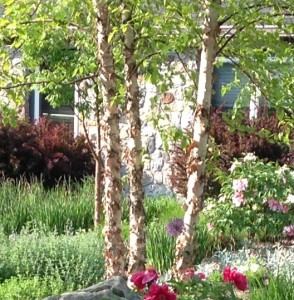Hello fellow readers, The influx of insects killing stands of trees is heartbreaking. But beyond the losses of our much-loved trees is an opportunity to plant beautiful native trees and shrub replacements.
We spoke before about how the emerald ash borer is devastating trees. They say roughly ten percent of the forests in our area are ash trees—a sad fate caused by an alien insect that made its way here. Then there’s the gypsy moth, intentionally brought to North America in 1869 to be bred as a hardy silkworm that has cycled through, destroying many trees. Perhaps you’ve heard the buzz about periodic cicadas—the next invader coming to town?
A bit about Brood X cicadas coming to town:
Brood X cicadas, also called the Great Eastern Brood, have been feeding on sap from roots underground for the last 17 years and are about to emerge. From Georgia, west to Illinois, north to Michigan, and all along the east coast from North Carolina to New York State, these suckers will emerge from the ground by the millions during May and June 2021.
Unlike the emerald ash borer and gypsy moth, periodical cicadas are native to the eastern United States and aren’t found anywhere else in the world. Of the seven species, four have 13-year cycles (seen more in the southeastern states), and three have 17-year cycles. As a result, species can overlap, sometimes emerging simultaneously.
Not to be confused with the annual cicadas that emerge July through September each year in relatively small numbers, periodic cicadas emerge in swarms in late May or early June. They’re smaller than the annual green ones, sporting primarily black with reddish-orange wing veins and eyes.
Native Tree and Shrub replacements provide opportunities
So how are these problems in the garden of life opportunities for new growth? Recently I visited with Andrew and Jaime of Swiftwater, PA, who are preparing to build their forever home. Their first task is removing the oaks killed by gypsy moth. Next, I suggested indigenous trees, including flowering understory trees and shrubs, to reforest areas.
Native Hemlocks (Tsuga canadensis) and White Pine (Pinus strobus) are thriving there, unaffected by wooly adelgid and deer—good choices for evergreen re-forestation if you’re as fortunate in your neighborhood. Finally, there’s Norway Spruce (Picea abies) though some consider them invasive in our area.
Deciduous trees such as Red Maple (Acer rubrum) and River Birch (Betula nigra) are ideal for medium to wet areas. There’s Sour gum (aka Black Tupelo, Nyssa sylvatica), Tulip Tree (Liriodendron tulipifera), and American Sweetgum (Liquidambar styraciflua) are excellent native trees suitable to replace our lost oaks and ash trees.
Native understory trees and shrubs that thrive along a woodland edge include Serviceberry (Amelanchier canadensis or A. arborea), Eastern Redbud (Cercis canadensis), American hornbeam (Carpinus caroliniana), Hawthorn(Crataegus coccinea), and American fringe tree (Chionanthus virginicus). Then there’s the adored Native Dogwood (Cornus florida) though sadly, they can become diseased. Plus, Sweetbay Magnolia (Magnolia virginiana) that flower best in full sun.
When will Brood X reach their peak?
Recent reports predict Brood X will reach their peak in early to mid-June. First, they’ll surface and molt to become adults with wings. Then they find their way onto deciduous trees and shrubs to mate.
The loud shrill are the males singing to attract the females. But it’s the females that cause damage when cutting slits into branches to lay eggs. On a positive note, they don’t sting or bite and provide protein for wildlife such as birds even foxes.
Newly planted trees and shrubs are most at risk.
Newly planted trees and shrubs and those compromised in health are most at risk, and annuals, including vegetables, and perennials should be unaffected.
Speaking of foxes, a momma fox and young kit gallivanted around the vegetable garden on Mother’s Day. You may recall the column featuring two frolicking foxes I suspected were courting (link below). Perhaps they made the groundhog abode nearby their own. They’ll likely move on before pilfering ripening veggies. First, though, I invite them to tend to the Brood-X cicadas before they go. Fingers crossed :-).
Garden Dilemmas? AskMaryStone@gmail.com (and your favorite Podcast App.)
Link to a related column about annual cicadas in Cicadas Sing ‘Back to School,’ and the story about Foxes in the Garden. Plus, more about Emerald Ash Borer a Lost Cause?





